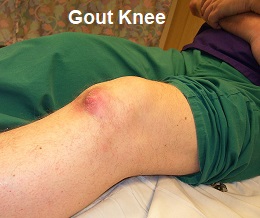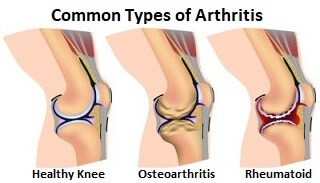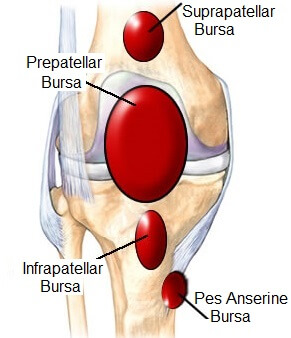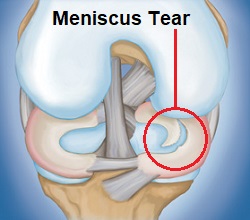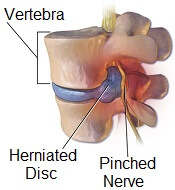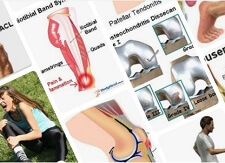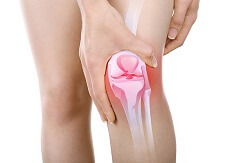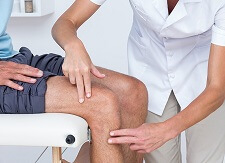- Home
- Knee Symptoms
- Burning Knee
Burning Knee Pain
Written By: Chloe Wilson, BSc(Hons) Physiotherapy
Reviewed by: KPE Medical Review Board
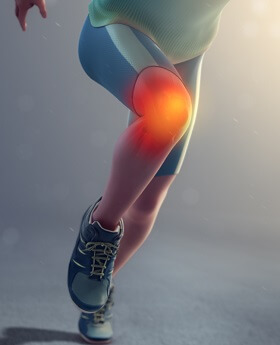
Burning knee pain can be extremely unpleasant. It may feel like the joint is on fire or that there is something sharp sticking in to the joint causing a horrible burning sensation.
It often affects sleep, either making it difficult to get to sleep or waking you up frequently, and unfortunately, when we are tired, pain always feels worse.
In most cases, it indicates a problem in the knee joint itself, but sometimes, it may actually be causes by a problem somewhere else such as the lower back referring pain to the knee.
Here we will look at the common causes of burning sensations in and around the knee, how to work out which one is causing your problem and what you can do to make it stop.
We will start by looking at what may be wrong in the knee joint itself, and then go on to look at other things from elsewhere in the body that can cause burning knee pain.
Common Causes Burning Knee Pain
The most common causes of burning knee pain are usually linked with inflammation and swelling in the knee joint. The excess fluid places pressure on the soft tissues and the inflammatory chemicals irritate the nerve endings.
1. Gout Knee
Gout is a very common cause of burning knee pain. Gout is an inflammatory condition caused by high levels of uric acid in the bloodstream.
Gout pain usually comes on rapidly over a few hours, typically at night time and people often describe it as feeling like their knee is on fire. The joint becomes red and swollen and often feels hot to touch. It is usually extremely painful and can make it difficult to walk.
Episodes usually settle within a few weeks but often return after a few months, and many people have multiple episodes.
There are various medications that can help to reduce the inflammation and pain and simple diet changes can help to prevent gout attacks from becoming a recurring thing.
In the Gout Knee section you can find out all about the common causes, symptoms, diagnosis, treatment and prevention options.
2. Knee Arthritis
The term arthritis means “joint inflammation”. There are two main types of arthritis, osteoarthritis and rheumatoid arthritis, both of which cause burning knee pain.
With Osteoarthritis there is wear and tear of the knee bones and cartilage. It may affect one or both knees, and the pain will only develop in the affected joint, not elsewhere in the body.
Arthritis typically affects people over the age of 65. The pain tends to be worse in the mornings or after sitting for long periods, and gradually eases with movement. Knee movement may gradually become restricted with arthritis and the knee may swell at times.
Rheumatoid Arthritis is a chronic, systemic inflammatory condition which causes swelling in joints making them painful, warm and stiff. It typically affects a number of joints at the same time so symptoms are unlikely to be confined just to the knee.
Symptoms of rheumatoid arthritis tend to fluctuate with people commonly yo-yoing between flare-ups and periods of remission.
In the knee arthritis section there is lots of information about the causes, diagnosis and symptoms and loads of great treatment tools to reduce arthritis pain and stiffness.
3. Knee Bursitis
Knee bursitis is another common cause of burning knee pain. All around the body there are bursa – small fluid filled pockets that sit between soft tissues and bone to allow smooth movement and reduce friction.
There are fifteen bursa located around the knee and inflammation of any of them can result in burning knee pain. There is usually obvious swelling – an inflamed bursa often resembles a small, squashy orange.
Symptoms of knee bursitis tend to come on gradually due to repetitive friction on the bursa, but occasionally bursitis can develop rapidly after an injury.
The most common types of bursitis that produce a burning type knee pain are:
- Prepatellar Bursitis: at the front of the knee aka Housemaids Knee
- Semimembranosus Bursitis: behind the knee aka Bakers Cyst
- Pes Anserine Bursitis: inner side of the knee
- Iliotibial Bursitis: outer side of the knee
- Infrapatellar Bursitis: just below the knee
In the knee bursitis section we look at each type of bursitis, what causes them to develop, common symptoms and the best treatment options.
4. Infection
One of the less common causes of burning knee pain is a bacterial infection in the joint, also known as septic arthritis. Here bacteria enter the body and travel to the knee and the joint quickly becomes infected.
With a bacterial infection, as well as pain, there will be redness and swelling and you will most likely feel unwell with a high temperature and fatigue. In most cases, only one knee is affected.
Knee joint infection is usually treated with intravenous and/or oral antibiotics. If there is a large build-up of fluid, your doctor may drain it with a needle, known as aspiration. In most cases this reduces the pain almost instantly.
If you suspect you have a knee infection, you should seek medical assistance immediately.
5. Trauma
Some knee injuries can cause a burning type pain usually accompanied by other symptoms such as instability, stiffness, popping or locking.
Sudden twisting of the knee, a blow to the joint, an RTA or a fall can all injure the bones, e.g. a fracture and soft tissues e.g. cartilage tear in and around the knee. This causes bleeding into the joint which places pressure on the nerve endings and causes a burning sensation in the knee.
You will usually know when you have injured the knee. There will be an isolated incident that kicked off the pain rather than it coming on gradually, and the burning knee pain will only be in the affected joint, the other knee will be totally fine.
You can find out all about the different types of injuries that can cause burning knee pain, including how they present and how to treat them in the common knee injuries section.
Other Causes of Burning Knee Pain
Burning knee pain doesn’t always indicate a problem in the knee joint itself, the problem may be further afield.
1. Nerve Damage
Damage or irritation of nerves can cause burning knee pain. Nerves are the vessels that carry signals between your brain/spinal cord and the rest of your body.
If a nerve gets irritated or squashed, it typically produces a burning type pain. The damage may occur anywhere along the path of the nerve down the leg or at its root source, the spine. The most common types of nerve damage that cause burning knee and thigh pain are sciatica and meralgia paresthetica.
If the problem is in the spine itself, there may be some back pain, but this is not always the case.
Burning pain from a neuropathy is often associated with other symptoms including weakness and abnormal sensations such as tinging or numbness. You can find out more in the nerve pain section on our sister site.
2. Peripheral Artery Disease
Peripheral artery or vascular disease can result in a decrease in blood flow to the legs, which causes a burning sensation in the calves and feet and occasionally up to the knee.
The pain with PAD tends to be worse when you are on your feet and eases when you rest and may be accompanied by cramping and numbness in the calves and feet.
In most cases peripheral artery disease is caused by a build-up of plaque in the blood vessels, known as atherosclerosis, but it can develop due to other things such as smoking and diabetes. Symptoms tend to affect both legs.
Warning Signs To Watch For
Occasionally, burning knee pain can be a sign of a serious underlying medical problem. If you experience any of the following symptoms, you should seek urgent medical attentions
- Progressive weakness and or numbness in your legs
- Problems with bladder or bowel control
- Slurred speech
- Vision disturbance
- High temperature
- Unexplained weight loss
- Severe pain, particularly at night
If your symptoms are affecting more than one part of your body, you should also get checked out by your doctor.
Symptom Checker
Here's a quick guide to the most common causes of burning knee pain with different activities:
Burning Knee Pain At Night: If your burning knee pain is worse at night, it is most likely to be gout knee. However, be aware that night pain can be a sign of a serious underlying medical condition so always check with your doctor.
Burning Sensation In Knee When Kneeling: If you get a burning sensation in your knee when kneeling, it is likely that something is getting squashed in your knee. People often say it feels like kneeling on a red hot poker. The most likely causes are knee bursitis or a meniscus tear.
Burning Pain In Knee After A Fall: If your burning knee pain is the result of a fall, chances are you have injured part of the knee. Chances are there is knee swelling which may be pressing on the nerves causing the burning sensation in your knee. If you landed directly on your knee, you may have injured the kneecap.
Burning Sensation Behind Knee: If you get a burning sensation behind your knee then the most likely cause, particularly if it is associated with swelling, is a Bakers Cyst. Another possibility is hamstring tendonitis
Burning Knee Pain When Resting: If the burning sensation in your knee gets worse when you rest or you notice it most when you first get up after resting, there may be wear and tear in your joint from arthritis. The pain typically subsides once you're up and about. Also bear in mind that pain that is worse with rest can indicate an underlying pathology so always check with your doctor.
Burning Knee Cap: A burning sensation at the kneecap typically indicates a problem with the cartilage lining the back of the knee cap, typically patellofemoral pain syndrome or chondromalacia patella.
Burning Knee Pain After Running: If you mainly notice your burning knee pain after running, it typically indicates a soft tissue problem. If the pain is mainly at the front of the knee it is likely to be from patellar tendonitis, if the pain is more on the outer side of the knee then it is probably due to Iliotibial Band Syndrome and if it is behind the knee, it is probably hamstring tendonitis
Worse With Movement: Peripheral Artery Disease, Bursitis, Gout, Trauma
Constant Burning Pain: Neuropathy, Trauma, Infection, Gout (NB may indicate a serious underlying medical condition - seek medical advice)
One Knee Affected: Gout, Arthritis, Bursitis, Infection, Meralgia Paresthetica or Trauma
Both Knees Affected: Peripheral Artery Disease, Neuropathy
Remember, any new case of burning knee pain should be reviewed by your doctor.
Related Articles
References
1. Livestrong: What Causes Burning Knee Pain After Exercise?
2. Medline Plus: Femoral nerve dysfunction
3. American Family Physician Journal. Evaluation of patients presenting with knee pain: Part II. Differential diagnosis. September 2003
4. Osteoarthritis and Cartilage Journal: Neuropathic pain symptoms in a community knee OA cohort. June 2011
Last Updated: April 30th, 2025
Next Review Due: April 30th, 2027
